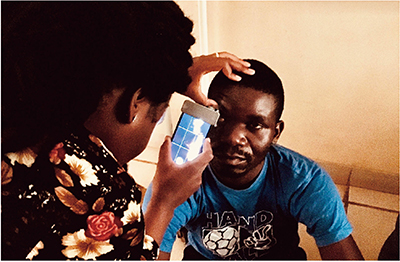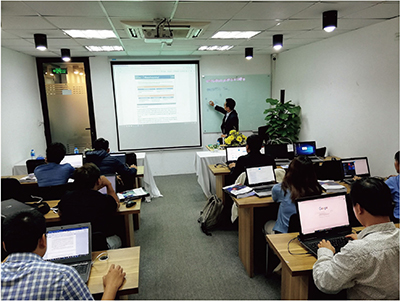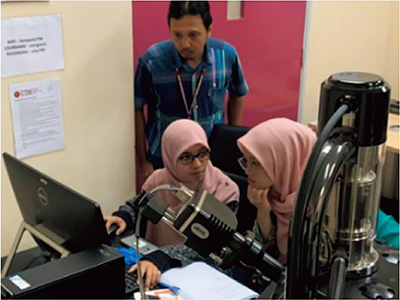(2) Digital, Information and Communications Technology, and Science and Technology
Developing countries’ growth and the international community’s development cannot proceed properly without responding to the digitalization of economic and social activities. Digital technology has become more pervasive in people’s lives and industrial activities, and the benefits of cyberspace, which is an important foundation for daily life and socio-economic activities, are expanding. On the other hand, the threat of cyber-attacks is becoming more serious, including damage caused by leaks of personal and corporate information and risks to national security from attacks on critical infrastructure. Therefore, it is becoming increasingly important to help developing countries reap the benefits of digitalization while mitigating its risks. Furthermore, since the impact of events in cyberspace can easily cross borders and cyber incidents occurring in other countries can also affect Japan, it is important to implement multi-layered cooperation and collaboration at various levels, including among governments and the private sector.
● Japan’s Efforts
■ Promotion of Digital Transformation (DX)

Test driving autonomous agricultural machinery as part of an agricultural pilot project in cooperation with Yanmar Agribusiness Co., Ltd. that utilizes high-precision positioning data in Sara Buri Province, Thailand (Photo: JICA)

Confirming the effectiveness of the Smart Eye Camera (SEC), a device that uses a smartphone camera to enable ophthalmic exams in order to improve eye treatment in rural areas of Malawi (Photo: OUI. Inc.)
The spread of COVID-19 has led to a period of disruption in the movement of people and goods, resulting in the digitalization and onlineization of socio-economic activities. Digital transformation (DX)Note 14 is directly linked to all development challenges and is the key to achieving “quality growth.”
In order to realize an inclusive and prosperous society in which developing countries and their people can benefit from digitalization in a safe, fair, and stable manner, Japan has identified the promotion of digitalization and DX as one of the areas in which Japan will strategically implement ODA through the “Co-creation for common agenda initiative” (see Part I, Section 1, and Part V, Section 2 (2) C. for details on the “Co-creation for common agenda initiative”). Furthermore, through collaboration with various actors, including international organizations and private companies, Japan supports the development of legal and judicial systems, human resources development, and the development of information and communication environments as part of the establishment of foundations for promoting digitalization based on the concept of “Data Free Flow with Trust (DFFT),”Note 15 which Japan advocates. In doing so, Japan promotes cooperation aimed at solving issues through the promotion of digitalization and enhancing development outcomes.
Areas where development benefits are expected to increase through DX include smart agriculture, remote medical care, smart cities, mobile banking, and the digitalization of government administration. As an example of Japan’s new cooperation initiative, since 2021, Japan has provided remote advice and training on medical technologies and expertise needed in developing countries by connecting medical professionals from Japan and those in developing countries via a communication system in approximately 10 countries in order to improve the medical systems in developing countries steadily. In addition, as part of cooperation to promote DX in the agricultural sector, a training course on Smart Food Chains (SFC)Note 16 entitled “Human Resource Development on Private-Public-Academia for Agricultural and Rural DX/Smart Food Chain Co-Creation” was held in Hokkaido for approximately two months from June 2023, in which 12 people from 11 Latin American and the Caribbean countries participated. With the cooperation of universities and private companies, the training included practical training and demonstrations on agricultural machinery that utilizes digital technology, such as robotic tractors for field farming, as well as tours of factories.
In order to concretely advance DX, the JICA DXLab was launched in 2022 as an initiative that enables rapid and timely demonstration experiments with digital partners with excellent technology. JICA opens up its assets, such as the sites of its ODA projects in 150 countries and the networks it has cultivated, as a place for co-creation in the digital domain to support the resolution of issues in developing countries and the business expansion of its digital partners. By December 2023, a total of four projects had been implemented in Ethiopia, India, and Indonesia.
■ Information and Communications Technology (ICT)

A discussion on disaster prevention equipment operation guidelines under the “Digital Terrestrial Television Broadcasting Network Operational Capacity Improvement Project” in the Maldives (Photo: Yachiyo Engineering Co., Ltd.)

Providing certified white hat hacker training as part of the “Project on Capacity Building for Cyber Security” in Viet Nam (Photo: JICA)
The dissemination of Information and Communications Technology (ICT)Note 17 contributes to the upgrading of industry and improvement of productivity as the establishment of a foundation for DX. It also contributes to solving social issues of medical care, education, energy, environment, disaster risk reduction and other areas, and helps promote democratization by encouraging information disclosure and establishing broadcasting media.
Japan promotes “quality infrastructure investment” in the ICT field in developing countries.Note 18 It actively supports the establishment of telecommunications and broadcasting equipment and facilities, the introduction of the technology and systems they require, and relevant human resources development. Specifically, Japan actively works to support the overseas promotion and the introduction of the Integrated Services Digital Broadcasting-Terrestrial (ISDB-T),Note 19 which has been adopted in a total of 20 countriesNote 20 in Latin America and the Caribbean, Asia, Africa, and other regions as of April 2023. Japan also conducts training programs through JICA every year for countries adopting or considering ISDB-T. The Ministry of Internal Affairs and Communications (MIC) also promotes assistance that offers ICT solutions to resolve social issues through dialogues and joint projects with partner governments.
Japan works with the International Telecommunication Union (ITU)Note 21 to provide a variety of development assistance in the fields of telecommunications and ICT to developing countries. Since October 2020, under the COVID-19 pandemic, Japan has cooperated with the ITU to launch Connect2Recover (C2R), which supports developing countries and regions mainly in Africa to draft national strategies for strengthening digital infrastructure and improving their usage environments. Among the pilot projects in the “Giga” initiativeNote 22 jointly implemented by ITU and the United Nations Children’s Fund (UNICEF), Japan has provided support for introducing internet connectivity to schools in Rwanda. Starting in 2022, Japan has supported Zimbabwe and Mauritania in evaluating the resilience of their network infrastructure, developing maps that show the connection status of telecommunications networks before and after natural disasters, and formulating national strategies for the dissemination of ICT. Additionally, as a result of reaching out to various countries to expand the C2R project, the Governments of Australia, Czech Republic, and Lithuania have decided to provide funding, and the area of activities expanded to countries in Asia, the Caribbean, and the Commonwealth of Independent States (CIS).
In the Asia-Pacific region, the Asia-Pacific Telecommunity (APT)Note 23 contributes to the balanced development of the telecommunication services and information infrastructure in the region. In order to promote human resources development related to telecommunications, Japan finances a number of training programs conducted by APT every year. In FY2022, 10 training programs including on broadband networks and cybersecurity were implemented and attended by approximately 150 people from the APT member states. The trainees utilize Japanese technology for the development of their own countries’ ICT, and Japanese companies’ expansion into the Asia-Pacific region is also expected through introducing Japanese technology systems.
In the Asia-Pacific region, over 2 billion people do not have internet access due to factors including the fragile infrastructure and the inability to afford it. In the Association of Southeast Asian Nations (ASEAN) region and Pacific Island countries, Japan develops an environment to make low-cost, high-speed internet available even in remote islands and areas.
■ Cybersecurity
In recent years, it has become a pressing task to take measures against threats to a free, fair, and secure cyberspace. It is thus necessary for diverse entities in each country to work together in order to respond to this issue. The lack of security-related awareness and response capacity in some countries, including developing countries, poses a significant risk to the entire world, including Japan. Therefore, strengthening cooperation for ensuring the security in cyberspace of countries around the world and providing capacity building support to developing countries not only contribute to the recipient countries, but also benefit the entire world including Japan.
Japan has strengthened cooperation with ASEAN through the ASEAN-Japan Cybercrime Dialogue and the Japan-ASEAN Information Security Policy Meeting. Japan continued to conduct tabletop exercises and other exercises with ASEAN member states in 2023, while also conducting the International Conference on ASEAN-JAPAN Cybersecurity Community (IC-AJCC) commemorating the 50th Year of ASEAN-Japan Friendship and Cooperation. In addition, through the International Criminal Police Organization (INTERPOL), Japan supported the strengthening of the investigative capacity of officials at law enforcement related agencies to deal with crimes committed in cyberspace, which increased under the COVID-19 pandemic.
Japan and ASEAN have concurred to further strengthen their cooperation on the issues related to cyber-attacks. As a specific initiative, Japan conducts cybersecurity exercises and other programs at the “ASEAN-Japan Cybersecurity Capacity Building Centre (AJCCBC),” which was established in Bangkok, Thailand, through the Japan-ASEAN Integration Fund (JAIF).Note 24 By February 2023, 1,480 people had participated in the training and other programs. In addition, in March 2023, support for the operation of the AJCCBC began as technical cooperation through JICA under the “Project for Enhancing ASEAN-Japan Capacity Building Program for Cybersecurity and Trusted Digital Services.”
At the AJCCBC, Japan provides the Cyber Defense Exercise with Recurrence (CYDER), a practical exercise targeted at cybersecurity personnel of government agencies and critical infrastructure operators in ASEAN countries, and promotes cooperation in capacity building in the area of cybersecurity in ASEAN. Since March 2023, Japan has been working to further enhance the content by adding new training for exercise trainers and exercises based on needs surveys in ASEAN countries. In November, the Cyber SEA Game was held and young engineers and students selected from ASEAN countries competed using their cybersecurity skills.
Japan also contributed to the World Bank’s Cybersecurity Multi-Donor Trust Fund and works on capacity building assistance in the field of cybersecurity for low and middle-income countries.
The National Police Agency (NPA) has conducted training for staff engaged in combatting cybercrimes at the People’s Public Security of Viet Nam since 2017, with the aim of helping them acquire the knowledge and skills for dealing with cybercrimes, as well as strengthening cooperative relations between the security agencies of Japan and Viet Nam.
■ Promoting Science, Technology and Innovation, and Research and Development

Research in the electron microscope laboratory of the Malaysia-Japan International Institute of Technology in Kuala Lumpur, Malaysia (Photo: JICA)
In the world today, social changes occur and information and communication technology (ICT), artificial intelligence (AI), and robotics are utilized in diverse industries, including not only the manufacturing industry and the service industry but also agriculture and construction.
Based on “the 2030 Agenda for Sustainable Development (2030 Agenda)”Note 25 (Paragraph 70), the UN has established the UN Inter-agency Task Team on STI for the SDGs (UN-IATT) and promotes Science, Technology, and Innovation for SDGs (STI for SDGs) on a global scale, in cooperation with countries. The UN Multi-Stakeholder Forum on Science, Technology, and Innovation for the Sustainable Development Goals (STI Forum) was held again in 2023. Expectations for STI are internationally increasing as a key to achieve the SDGs while optimizing limited resources.
In the process of Japan’s economic development, Japan has overcome its own challenges in fields such as health and medical care, environment, and disaster risk reduction, fully utilizing STI. Based on these experiences, Japan is engaged in science and technology cooperation through the “Science and Technology Research Partnership for Sustainable Development (SATREPS) program”Glossary and others in order to resolve challenges faced by developing countries. SATREPS, which links ODA and the science and technology budget, was launched in 2008 to support joint research between research institutions and researchers in science and technology fields in Japan and developing countries. 191 research projects in 56 countries around the world have been adopted by FY2023. The development of a sustainable land management framework to combat desertification in Ethiopia is a good example of SATREPS that contributes to resolving challenges in developing countries (see also “Master Techniques from Japan to the World).
The UN-IATT conducts the “Global Pilot Programme” to promote the development of an STI roadmap for the SDGs in countries worldwide, including six pilot countries: India, Ukraine,Note 26 Serbia, Ethiopia, Ghana, and Kenya. Under this Programme, Japan has supported Kenya in the agricultural sector from FY2020 to FY2022 through contributions to the World Bank. In addition, since FY2020, Japan has supported Japanese companies that consider launching projects to resolve social challenges in developing countries through STI, through contributions to the United Nations Development Programme (UNDP), and made efforts to share knowledge gained through this support among developing countries.
In terms of support for research and development, Japan is building a next-generation network based on cooperation in human resources development by strengthening assistance for overseas engineering universities.
In Asia, Japan provides support to the Malaysia-Japan International Institute of Technology (MJIIT), which was founded with the aim of establishing Japanese-style engineering education, by procuring equipment and supplies for education and research and by developing curriculum designs, while also conducting cooperation on education and research with Japanese universities. As of 2023, a consortium of 29 universities and two research institutes, among others, has been organized to promote people-to-people exchanges between Japan and Malaysia through joint research and exchange programs. In 2023, the Malaysia-Japan Linkage Office was established within MJIIT as a liaison office to strengthen collaboration with Japanese universities and industries.
Since 2012, Japan has provided scholarships to students studying remote sensing (satellite image analysis) in courses taught by Japanese instructors at the Asian Institute of Technology (AIT) located in Thailand, contributing to the development of the human resources who will constitute the crux of the space industry development in the Asian region.
Japan and Egypt have been cooperating under the Egypt-Japan University of Science and Technology (E-JUST) project since 2008. The university was established based on the concept of “offering small class sizes, postgraduate and research-oriented, practical, and international standard of education, leveraging the characteristics of Japanese-style engineering education.” With the cooperation of universities in Japan, assistance was provided in the areas of developing curriculum and dispatching experts and professors. Initially established as a graduate university specializing in engineering-related fields, the university now also has the Faculty of Engineering, the Faculty of Science, and the Faculty of International Business and Humanities. E-JUST has been highly praised for its achievements, including joint research and joint supervision with Japanese researchers, exchange student programs and internationalization undertaken by both Japanese and Egyptian governments, and collaboration with Japanese companies. E-JUST was ranked as the top university in Egypt and 7th on the African continent, and placed between 601st and 800th in the world, in the World University Rankings published by the UK’s Times Higher Education (THE) in September 2023. E-JUST also supports the admission of international students from the Middle East and Africa, contributing to the development of industrial, scientific and technological human resources in the regions (see “Stories from the Field 3” for development plan of Indian Institute of Technology Hyderabad).
Glossary
- Science and Technology Research Partnership for Sustainable Development (SATREPS) program
- Through the collaboration of Japan’s advanced science and technology and ODA, SATREPS aims to resolve global issues in the fields of environment and energy, bioresources, disaster risk reduction, and infectious disease control. Under this program, research institutes both in developing countries and Japan work together to conduct international joint research with the following objectives: (1) enhancing international cooperation in science and technology, (2) acquiring new knowledge and technologies that lead to the resolution of global issues, and through this process, creating innovations (3) promoting capacity development. The Ministry of Foreign Affairs (MOFA) and JICA, in collaboration with the Ministry of Education, Culture, Sports, Science and Technology (MEXT), the Japan Science and Technology Agency (JST), and the Japan Agency for Medical Research and Development (AMED), provide support to research institutes and researchers in Japan and the developing countries.
- Note 14: Making people’s lives more convenient and enriching them through the introduction of new information technologies, and generating new value by recreating existing business structures with the introduction of new digital technologies, etc.
- Note 15: The concept of DFFT aims to promote the free international flow of data, where data that is useful for solving business and social issues can flow freely without regard for borders, while ensuring trust in terms of privacy, security, and intellectual property rights. DFFT was proposed by then Prime Minister Abe at the World Economic Forum Annual Meeting (Davos Conference) held in Geneva, Switzerland, in January 2019 and was included in the G20 Osaka Leaders’ Declaration at the G20 Osaka Summit in June 2019 with the support of the leaders of participating countries.
- Note 16: SFC refers to a platform that connects and accumulates information from entrance (production) to exit (consumption), enabling the sophistication of production, the improvement of added value in sales, and the optimization of distribution.
- Note 17: ICT is a technology that integrates computers and other information technology with digital communication technology, as represented by the Internet and mobile phones.
- Note 18: In 2017, Japan formulated the Playbook for Investment in “Quality ICT Infrastructure” for ICT policymakers and procurement managers of the respective countries and regions.
- Note 19: A terrestrial digital broadcasting system that was developed in Japan. Its functions, such as an emergency alert broadcast system, TV broadcasting reception on mobile terminals, etc., and data broadcasting, give the system advantages in disaster response and the provision of diverse services.
- Note 20: The 20 countries are Japan, Angola, Argentina, Bolivia, Botswana, Brazil, Chile, Costa Rica, Ecuador, El Salvador, Guatemala, Honduras, Maldives, Nicaragua, Paraguay, Peru, the Philippines, Sri Lanka, Uruguay, and Venezuela.
- Note 21: A UN specialized agency that covers the fields of telecommunications and broadcasting. To ensure that people around the world are able to make use of telecommunications technologies, ITU organizes the following: (i) international allocation of radio frequencies used in mobile phones, satellite broadcasting, and other technologies, (ii) international standardization of telecommunications technologies, and (iii) support for development in the field of telecommunications in developing countries.
- Note 22: An initiative launched by UNICEF and ITU in 2019 with the aim of enabling internet access in schools around the world, focusing on developing countries.
- Note 23: An international telecommunication organization established in the Asia-Pacific region. Aiming for a balanced development of telecommunication services and information infrastructure in the Asia-Pacific region, it implements human resources development through training courses and seminars, and coordinates regional policies on standardization, wireless communications, and other telecommunication issues.
- Note 24: See Note 4.
- Note 25: See the glossary.
- Note 26: Since 2021.
